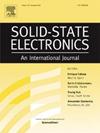Frequency-driven dielectric analysis of ultrathin HfOx-TiOx composite films
IF 1.4
4区 物理与天体物理
Q3 ENGINEERING, ELECTRICAL & ELECTRONIC
引用次数: 0
Abstract
This study investigates the frequency-dependent dielectric properties of ultrathin HfOx-TiOx composite films (HTO) in a metal–oxide–semiconductor (MOS) configuration over a frequency range of 1 kHz to 3 MHz. The films were deposited using a pulsed-DC magnetron sputtering technique in an atomic layer deposition-like manner, incorporating very thin TiOx layers within the bulk of HfOx. Structural analysis revealed that the films are amorphous and exhibit uniform and smooth surfaces. The dielectric constant (ε′) and dielectric loss (ε′′) exhibit a decreasing trend with increasing frequency, demonstrating typical dielectric behavior. Furthermore, the characteristic dielectric relaxation frequency shifts toward lower frequency values with the insertion of TiOx. The Cole-Cole plot confirms the non-Debye relaxation behavior across all samples. Optical spectroscopy analysis reveals a systematic increase in the optical band gap upon more TiOx insertion. Analysis of current–voltage (I-V) characteristics demonstrates low leakage currents across the composite films. Understanding the dielectric parameters and the electrical characteristics is crucial for the potential application of these films in advanced electronic applications.
超薄HfOx-TiOx复合薄膜的频率驱动介电分析
本研究研究了金属氧化物半导体(MOS)结构中超薄HfOx-TiOx复合薄膜(HTO)在1 kHz至3 MHz频率范围内的频率相关介电特性。薄膜是用脉冲直流磁控溅射技术以类似原子层沉积的方式沉积的,在HfOx的主体内结合了非常薄的TiOx层。结构分析表明,薄膜是无定形的,表面均匀光滑。介电常数(ε’)和介电损耗(ε’)随频率的增加呈减小趋势,表现出典型的介电特性。此外,随着TiOx的加入,特征介电弛豫频率向低频值偏移。Cole-Cole图证实了所有样本的非德拜松弛行为。光谱学分析表明,随着TiOx的加入,光学带隙系统地增加。电流-电压(I-V)特性分析表明,复合薄膜的漏电流较低。了解这些薄膜的介电参数和电学特性对于这些薄膜在先进电子应用中的潜在应用至关重要。
本文章由计算机程序翻译,如有差异,请以英文原文为准。
求助全文
约1分钟内获得全文
求助全文
来源期刊

Solid-state Electronics
物理-工程:电子与电气
CiteScore
3.00
自引率
5.90%
发文量
212
审稿时长
3 months
期刊介绍:
It is the aim of this journal to bring together in one publication outstanding papers reporting new and original work in the following areas: (1) applications of solid-state physics and technology to electronics and optoelectronics, including theory and device design; (2) optical, electrical, morphological characterization techniques and parameter extraction of devices; (3) fabrication of semiconductor devices, and also device-related materials growth, measurement and evaluation; (4) the physics and modeling of submicron and nanoscale microelectronic and optoelectronic devices, including processing, measurement, and performance evaluation; (5) applications of numerical methods to the modeling and simulation of solid-state devices and processes; and (6) nanoscale electronic and optoelectronic devices, photovoltaics, sensors, and MEMS based on semiconductor and alternative electronic materials; (7) synthesis and electrooptical properties of materials for novel devices.
 求助内容:
求助内容: 应助结果提醒方式:
应助结果提醒方式:


